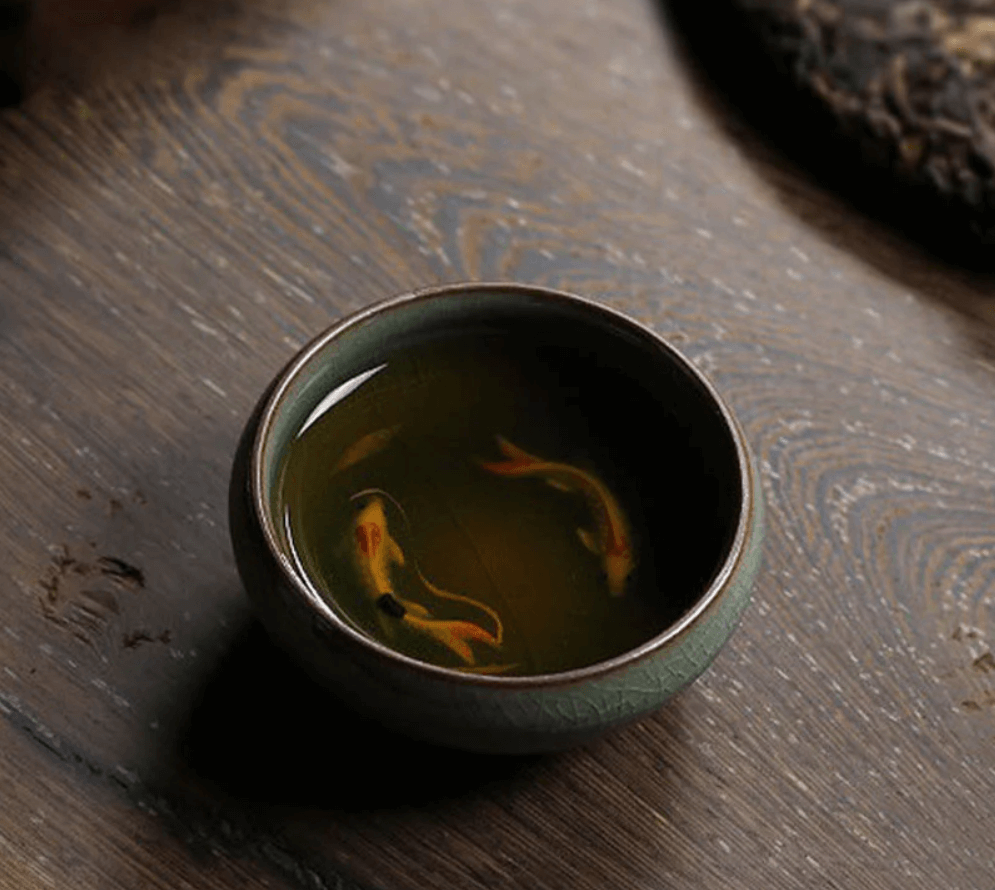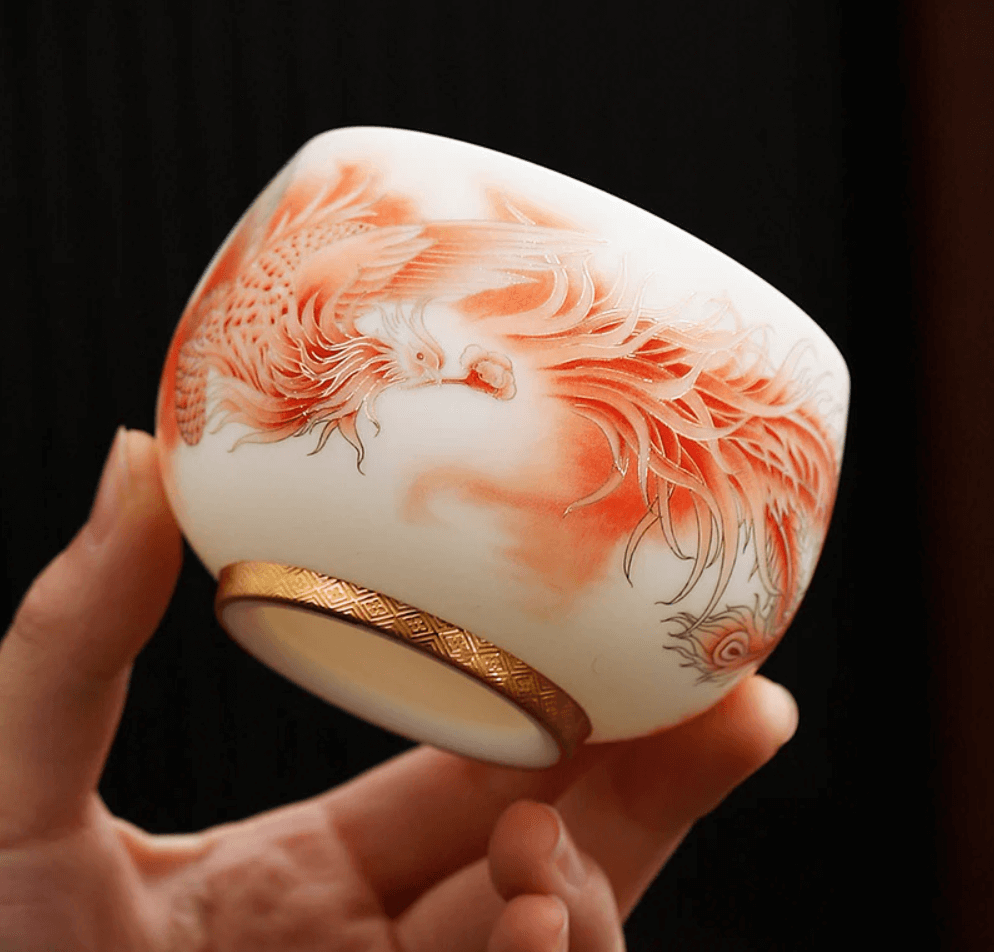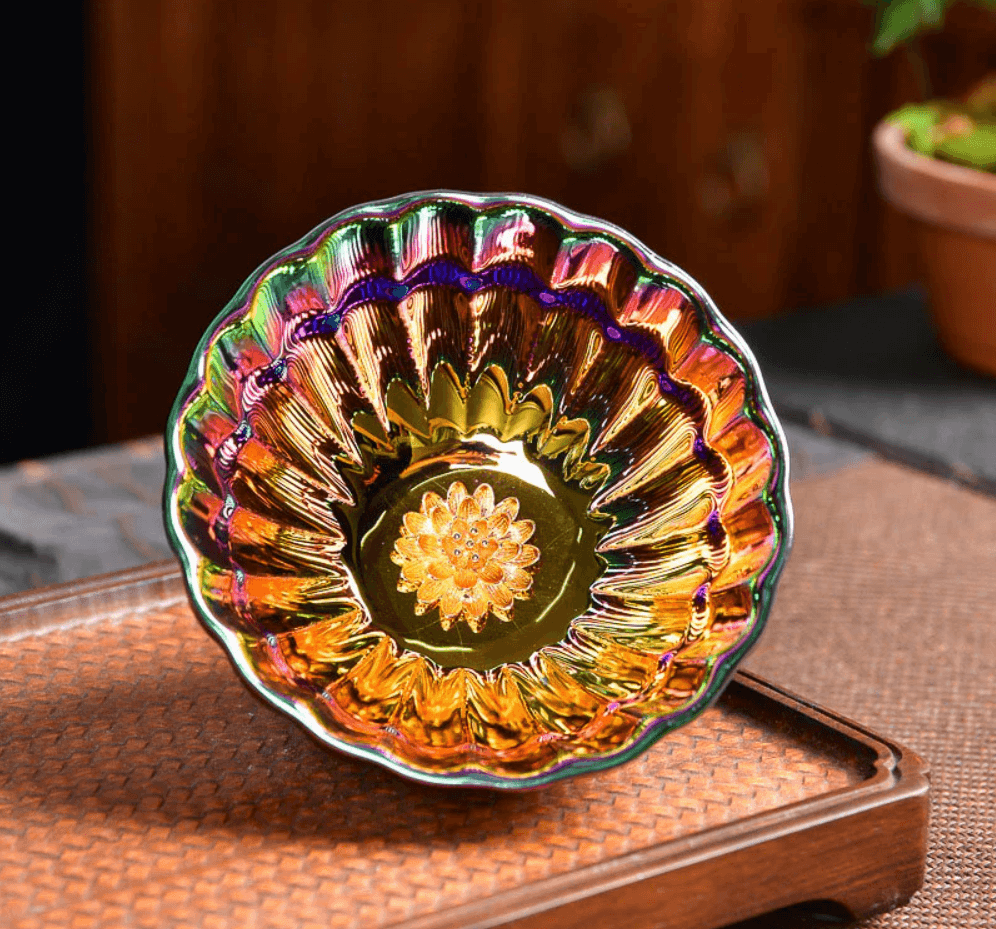Cups of Qiankun: A Thousand Years of Style and Elegance in Chinese Teacups
2025-05-12
Introduction: A Square Inch Cup, A Thousand Years of Flair
A cup of tea, half a volume of books, when the warm tea broth slides over the lips and teeth, the teacup has long transcended the attributes of a container and transformed into a miniature universe of the Chinese spiritual world. From the Shang and Zhou bronze jars to the Ming and Qing official kilns, from Lu Yu's “tea bowl” to the Song Huizong Qinding “Jianjian”, each tea cup is a slice of the times, engraved with the code of civilization. It is not only the elegant artifact on the desk of the literati, but also the daily life of the people, carrying the ultimate pursuit of oriental aesthetics - the aura of heaven and earth and the philosophy of nature, all of which are collected into the square inches that can be grasped in one's hand.
1.A Thousand Years of Tea Fragrance, Tracing Back to the Source
A cup of tea, half a volume of books, when the warm tea broth slides over the lips and teeth, the teacup has long transcended the attributes of a container and transformed into a miniature universe of the Chinese spiritual world. From the Shang and Zhou bronze jars to the Ming and Qing official kilns, from Lu Yu's “tea bowl” to the Song Huizong Qinding “Jianjian”, each tea cup is a slice of the times, engraved with the code of civilization. It is not only the elegant artifact on the desk of the literati, but also the daily life of the people, carrying the ultimate pursuit of oriental aesthetics - the aura of heaven and earth and the philosophy of nature, all of which are collected into the square inches that can be grasped in one's hand.
1.A Thousand Years of Tea Fragrance, Tracing Back to the Source
In China, the history of tea can be traced back to the Shennong era in 2737 BC. Legend has it that when Shennong tasted all kinds of herbs, he accidentally consumed poisonous herbs and accidentally drank water boiled with tea leaves to relieve the poison, which started the unbreakable relationship between the Chinese nation and tea. In the Tang Dynasty, Lu Yu wrote “The Book of Tea”, which systematically summarized the methods of planting, picking, making, cooking and drinking tea, sublimating tea-drinking from a mere thirst-quenching act to an art, marking the formal formation of tea culture.
With the development of the times, tea culture is constantly enriched. In the Song Dynasty, the prevalence of tea, the literati to meet friends with tea, tea competition, tea culture to a new peak; Ming and Qing dynasties, loose tea brewing method gradually replaced the point of tea, purple sand pots, celadon cups and other appliances came into being, and further promote the development and refinement of the tea utensils. Tea culture is integrated with Confucianism, Buddhism and Taoism, forming the tea ceremony spirit of “harmony, quietness, happiness and truth”, which has become an important part of the traditional culture of the Chinese nation.

2.The Art of Tea Brewing and the Appearance of Culture

2.The Art of Tea Brewing and the Appearance of Culture
Chinese tea brewing culture is the most vivid display of tea culture. Different types of tea have very different brewing methods. Green tea is tender and needs to be brewed in a glass cup at a water temperature of about 80°C to retain its fresh taste and green color; black tea is warm and suitable for brewing in boiling water, and the purple sand pot can better stimulate its mellow aroma; oolong tea has a rich aroma and is brewed in the “Kung Fu Tea” style, which is a way of showing the changes in its flavor through repeated brewing.
During the process of brewing tea, every action contains etiquette and wisdom. From ironing the cups and cleaning the utensils, to pouring the tea into the water, to distributing the tea to honor the guests, every hand and foot shows elegance and calmness. The “phoenix three nods” symbolizes the respect to the guests, and when distributing the tea, it is said that “the tea is full of deception, and the wine is full of respect”, all these details reflect the Chinese philosophy of cultivating oneself with tea and meeting friends with tea. Brewing tea is not only a demonstration of skill, but also a spiritual practice, in a brew, feel the serenity and peace, and realize the true meaning of life.
3.The flow of cups and lanterns, the beauty of form
3.The flow of cups and lanterns, the beauty of form
The evolution of the shape of the Chinese tea cup, like a concentrated history of civilization. Shang and Zhou period, bronze wine and eating utensils appeared in the prototype of similar tea cups, although not specifically for drinking tea, but for the development of tea laid the foundation. Tang Dynasty, with the rise of tea culture, specialized tea began to appear, tea bowl shape simple atmosphere, mostly open mouth, deep belly, jade bottom. Song Dynasty, the prevalence of tea, Jianzhan with its unique rabbit hair pattern, partridge spots become the best apparatus for tea, its deep tire, open mouth, easy to observe the color and shape of the tea froth.
Ming and qing dynasties, tea cup form more rich and diverse. Blue and white porcelain cup with its elegant blue and white pattern, delicate porcelain tire, become the hearts of the literati; enamel cup colorful, exquisite craftsmanship, show the court luxury; Zisha pot with its unique material and shape, loved by the tea people, and its “square is not a style, round is not the same phase” characteristics, showing the craftsmen's superior skills and unique The characteristics of “square is not a style, round is not a phase” show the craftsman's skill and unique aesthetic. From simple and heavy to delicate and elegant, the changes in the shape of teacups reflect the aesthetic style and cultural pursuits of different times.

4.Different materials, different flavors

4.Different materials, different flavors
The material of the teacup determines its unique flavor. Porcelain as the mainstream material of Chinese teacups, Jingdezhen celadon porcelain, pastel porcelain is the most famous. Its texture is delicate, glazed, can perfectly show the color and aroma of tea, and easy to clean, loved by the public. Glass teacups stand out with its translucent texture, when brewing, tea leaves in the water stretching floating posture is clearly visible, adding visual enjoyment to tea drinking.
Purple sand material teacup unique charm, it has good air permeability and water absorption, can absorb the tea flavor in the tea soup, make the tea soup more mellow and sweet. Long-term use of purple sand pot tea, even if you do not put the tea leaves, injected into the boiling water can also smell the faint aroma of tea. In addition, silver teacups with its noble texture and sterilization efficacy, in the ancient court and aristocrats favored; bamboo teacups exudes a natural atmosphere, giving a sense of freshness and simplicity. Teacups made of different materials to meet the diverse needs of people, but also for the tea culture has added rich colors.
5.Geometric aesthetics, the beauty of the cup
5.Geometric aesthetics, the beauty of the cup
The shape of Chinese teacups implies a unique geometric aesthetic. Jiantian type tea cups, such as Jianjian, tealight, mostly open mouth, slanting body, deep belly, smooth and natural lines, not only to facilitate the observation of the color of the tea broth, but also to gather the tea aroma. Pressing hand cup, its mouth edge flared, abdomen slightly bulging, the center of gravity in the bottom of the cup, held in the hand has a sense of calm and pressure, so the name “pressing hand cup”, reflecting the perfect combination of practicality and aesthetics.
Bucket hat cup, simple and elegant shape, shaped like an inverted bucket hat, the mouth is large and the bottom is small, the lines are sharp, giving a feeling of lightness and agility. Scenting cups, with a slender body design, are easy to gather tea aroma, allowing tea drinkers to enjoy the aroma of tea leaves before tasting it. Each cup type has been carefully designed, not only considering the practicality of brewing and drinking tea, but also incorporating the pursuit of beauty, the rhythm of geometric lines and the connotation of tea culture are perfectly integrated.
6.Glaze style, five elements of philosophy
The glaze color of Chinese teacups carries the Chinese reverence for nature and a deep understanding of the five elements philosophy. The beauty of celadon lies in its glaze color of “green after the rain”, a touch of warm green that seems to solidify the clarity and serenity of the sky after the rain on top of the body of the cup, embodying the vitality and spirituality of “wood”. The kiln-variable glaze colors of Jun kiln are as colorful as the evening sun, with red and purple mingling, resembling the warmth and exuberance of “fire”; the purity and elegance of the white porcelain symbolizes the introspection and purity of “gold”; the depth and heaviness of the black glaze contains the tolerance and profundity of “water”; and the warm and gentle green color seems to fix the clarity and serenity of the sky after rain on top of the cup body, reflecting the vitality and dynamism of “wood”. “ of tolerance and depth; and clay tea set of simple and natural, highlighting the “earth” of calm and heavy. These glaze colors are not only visual enjoyment, but also a vivid reflection of the Chinese philosophy of the five elements into the aesthetics of life.

7.Legends of Famous Weapons, Cultural Imprints
In the long history of Chinese teacups, some famous vessels carry deep cultural imprints. Ming Chenghua fighting color cocktail cup, with its exquisite baby play with the court tea closely linked. Legend has it that the emperor burned this cup for his favorite concubine Wan, the cup on the children playing scene, not only shows the leisure of court life, but also implies the meaning of praying for the prosperity of the heir. Emperor Qianlong for the taste of Wuyi rock tea, specially ordered Jingdezhen Imperial Kiln Factory burned “twelve flower god cup”, each cup body painted with different months of flowers, with the corresponding Tang poetry, tea, poetry, painting a perfect blend of tea, showing the royal tea culture of respect and innovation. These famous vessels are not only the pinnacle of craftsmanship, but also become witnesses of history and culture, telling a moving story.
Conclusion: There is heaven and earth in the cup, and the dry world can be seen in the tea.
From the tea leaves in the mountains and forests to the warm tea cups in your hands, Chinese tea culture has been passed down for thousands of years, and the philosophical idea of “the unity of heaven and mankind” has been integrated into every detail. The tea cup is no longer just a container for tea, but a spiritual totem that carries oriental aesthetics. It carries the way of the vessel, transforming the aura of all things in the world, the elegance of the literati, and the fireworks of the people in the marketplace into a world on the tea table. When we pick up a cup of tea, sipping is not only the aroma of tea, but also the precipitation of a thousand years of civilization. This obsession with tea and utensils is not only the adherence to traditional culture, but also the eternal pursuit of poetic life.
6.Glaze style, five elements of philosophy
The glaze color of Chinese teacups carries the Chinese reverence for nature and a deep understanding of the five elements philosophy. The beauty of celadon lies in its glaze color of “green after the rain”, a touch of warm green that seems to solidify the clarity and serenity of the sky after the rain on top of the body of the cup, embodying the vitality and spirituality of “wood”. The kiln-variable glaze colors of Jun kiln are as colorful as the evening sun, with red and purple mingling, resembling the warmth and exuberance of “fire”; the purity and elegance of the white porcelain symbolizes the introspection and purity of “gold”; the depth and heaviness of the black glaze contains the tolerance and profundity of “water”; and the warm and gentle green color seems to fix the clarity and serenity of the sky after rain on top of the cup body, reflecting the vitality and dynamism of “wood”. “ of tolerance and depth; and clay tea set of simple and natural, highlighting the “earth” of calm and heavy. These glaze colors are not only visual enjoyment, but also a vivid reflection of the Chinese philosophy of the five elements into the aesthetics of life.

7.Legends of Famous Weapons, Cultural Imprints
In the long history of Chinese teacups, some famous vessels carry deep cultural imprints. Ming Chenghua fighting color cocktail cup, with its exquisite baby play with the court tea closely linked. Legend has it that the emperor burned this cup for his favorite concubine Wan, the cup on the children playing scene, not only shows the leisure of court life, but also implies the meaning of praying for the prosperity of the heir. Emperor Qianlong for the taste of Wuyi rock tea, specially ordered Jingdezhen Imperial Kiln Factory burned “twelve flower god cup”, each cup body painted with different months of flowers, with the corresponding Tang poetry, tea, poetry, painting a perfect blend of tea, showing the royal tea culture of respect and innovation. These famous vessels are not only the pinnacle of craftsmanship, but also become witnesses of history and culture, telling a moving story.
Conclusion: There is heaven and earth in the cup, and the dry world can be seen in the tea.
From the tea leaves in the mountains and forests to the warm tea cups in your hands, Chinese tea culture has been passed down for thousands of years, and the philosophical idea of “the unity of heaven and mankind” has been integrated into every detail. The tea cup is no longer just a container for tea, but a spiritual totem that carries oriental aesthetics. It carries the way of the vessel, transforming the aura of all things in the world, the elegance of the literati, and the fireworks of the people in the marketplace into a world on the tea table. When we pick up a cup of tea, sipping is not only the aroma of tea, but also the precipitation of a thousand years of civilization. This obsession with tea and utensils is not only the adherence to traditional culture, but also the eternal pursuit of poetic life.

